________________
APPENDICES: 26
337
The initial syllables of the verses 1 and 2 viz. Hrim and Srim are additional Mantra-bijis at the beginning of the Pancadasāksari Vidyā proper. Such an addition is technically called 'Sirah' or the head of the Mantra or Vidyā. The Upāsanā of Srividyā gained greater currency because the same was set forth together with the relative diagrain Sricakra by Sri Sankarācārya in his hymn Saundaryalahari (See vv. 1,11 and 32* and Kameśvarasūri's commentary on the same). The addition of Ramābijai.e. Srim at the end converts Pancadasākşarī into Şodasākşarī Srividyā +. When out of the three Khandas of Pancadasāksari the first Khanda is 'Ha Sa Ka La' instead of 'Ka E I La' it is called Lopā. mudrā or Hādi Vidyā as it begins with the syllable 'Ha', the other being called Kādi as it begins with the syllable 'Ka'. Tripurasundari with 15 Nityās preside over Sodasakşarī or the 16 syllabled Srividyā which forms the basis of the Samaya mode of worship.
$ Sri Devyatharvasirşopanişad describes Pancadaśakşari Srividyā, Bahvịcopnişad refers to Srīvidya and Tripurātāpini and Bhāvanopanişad describe Sricakra.
fera: Tithi: Fra: f ara yfa: fafavor: स्मरो हंसः शक्रस्तदनु च परामारहरयः अमी हल्लेखाभिस्तिसृभिरवसानेषु घटिता
भजन्ते वर्णास्ते तव जननि नामावयवताम् ' ॥३२॥ + See all the hymns in 'Sri Lalitāstava amanimālā' (published by Nirnayasagara Press) which contain the 16 syllabled Srividya formed by putting together the initial syllables of the 16 verses of each of the hymns.
"The first four syllables of the Sodasākṣari constitute the first Khanda, relating to Agni; representing Kriyasakti, the Jägrat state, the Viśva-vịtti and Tamoguņa. The next five syllables coustitute the second Khanda, relating to Sūrya, representing Iccha-Sakti, the Svapna state, the Taijasavịtti and Rajo-guna. The Hțl-lekhā between the two represents the Rudra-granthi. The next three syllables constitute the third Khanda relating to Soma, representing Jñana-sukti, the Suşupti state, the Prājñavsiti and Sattva-guna. The Hộl-lekha between the second and third Khandas represents the Vişņu granthi. The fourth Khanda of one syllable, known as the Candrakala, which should be imparted by the Guru, is implied after the three aforesaid Khandas. The Hți-iekhă between the third and fourth Khandas represents the Brahma




